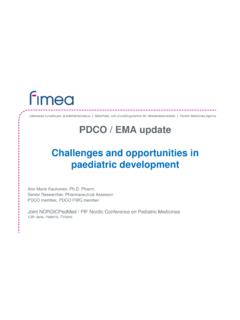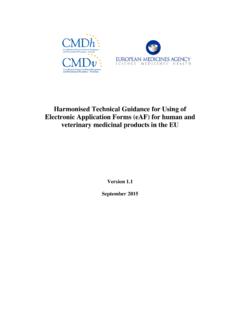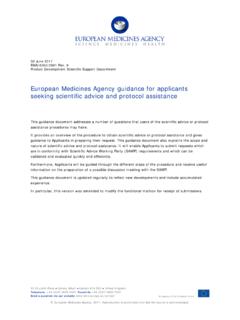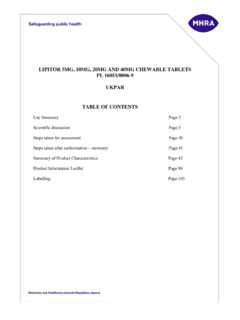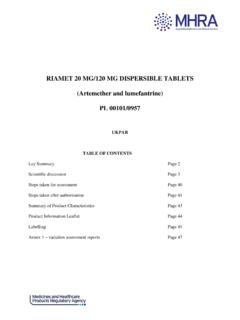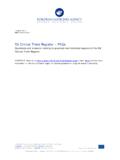Transcription of Guideline on pharmaceutical development of …
1 1 August 2013. EMA/CHMP/QWP/805880/2012 Rev. 2. Committee for Medicinal Products for Human Use (CHMP). paediatric Committee (PDCO). Guideline on pharmaceutical development of medicines for paediatric use Draft agreed by QWP February 2011. Draft agreed by SWP March 2011. Draft agreed by PDCO April 2011. Adoption by CHMP for release for consultation May 2011. End of consultation (deadline for comments) 31 December 2011. Revised version agreed by QWP for release for second consultation September 2012. Revised version agreed by PDCO for release for second consultation November 2012. Revised version adopted by CHMP for release for second consultation November 2012. End of second consultation (deadline for comments) 31 March 2013. Final version agreed by QWP June 2013. Final version agreed by PDCO July 2013. Final version adopted by CHMP July 2013. Date for coming into effect 15 February 2014. Keywords child, pharmaceutical development , quality 7 Westferry Circus Canary Wharf London E14 4HB United Kingdom Telephone +44 (0)20 7418 8400 Facsimile +44 (0)20 7418 8416.
2 E-mail Website An agency of the European Union European Medicines Agency, 2013. Reproduction is authorised provided the source is acknowledged. Guideline on pharmaceutical development of medicines for paediatric use Table of contents Executive summary .. 3. 1. Introduction (background) .. 3. 2. 4. 3. Legal basis .. 5. 4. General considerations .. 5. 5. Characteristics of the active substance .. 5. 6. Route of administration and dosage form .. 6. General considerations .. 6. Oral administration .. 6. Nasal preparations .. 11. Preparations for inhalation .. 11. Rectal 12. Cutaneous and transdermal preparations .. 12. Eye and ear preparations .. 12. Parenteral administration .. 13. Fixed dose combinations .. 14. 7. Dosing frequency .. 14. 8. Modified release preparations .. 14. 9. Excipients in the formulation .. 14. General considerations .. 14. Colouring agents .. 18. Flavours .. 18. Preservatives .. 18. Sugars and sweeteners.
3 18. 10. Patient acceptability .. 19. 11. Container closure system, measuring device, administration device and packaging .. 21. General considerations .. 21. Container size .. 22. Measuring device .. 22. Other devices .. 23. 12. User information (summary of product characteristics and package leaflet) .. 23. Definitions .. 23. Guideline on pharmaceutical development of medicines for paediatric use EMA/CHMP/QWP/805880/2012 Rev. 2 Page 2/24. Executive summary The paediatric Regulation aims to facilitate the development and accessibility of age-appropriate paediatric medicines. This aim should be achieved without subjecting children to unnecessary clinical trials and without delaying the authorisation of medicinal products for other age groups. Critical objectives for the development of age-appropriate paediatric medicines is to ensure that children in the target age group(s) will have access to medicinal products with a positive benefit-risk balance, of a consistent quality, assuring adequate patient adherence and which do not put an unnecessary burden on the patient and/or its caregivers.
4 This Guideline is intended to provide additional guidance for the pharmaceutical development of medicinal products for children between birth and 18 years of age. This Guideline should be read in conjunction with all other relevant EU legislative and guiding documents (see section 3). The Guideline takes due account of the scientific and technical progress in the manufacture and control of paediatric medicines at the date of coming into operation. 1. Introduction (background). On the 26th of January 2007, the paediatric Regulation entered into force (Regulation EC No 1901/ 2006 of the European Parliament and of the Council, amending regulation EEC No 1768/92, Directive 2001/20/EC, Directive 2001/83/EC and Regulation EC No 726/2004). The Regulation aims to facilitate the development and accessibility of medicinal products for use in the paediatric population, to ensure that medicinal products used to treat the paediatric population are subject to research of high quality and are appropriately authorised for use in the paediatric population, and to improve the information available on the use of medicinal products in the various paediatric populations.
5 As a result of the aforementioned, it is expected that the number of authorised paediatric medicinal products and the knowledge on the quality aspects critical to these products will rapidly increase. The physical, metabolic and psychological processes inherent to growth from birth into adulthood reveal that children can not be regarded as small adults nor they can be regarded as a homogeneous group in themselves. As a consequence, clinical trials in adults are not necessarily predictive for children. Thus, in many cases clinical trials will be needed in children of different ages in order to demonstrate that a paediatric medicine is safe and effective in all of the target age group(s) for which the medicine is being developed. In addition, the treatment of children with medicines poses specific pharmaceutical problems which have not been seen to the same extent in adults, and whose occurrence may be age dependent. For example, infants are simply unable to swallow conventionally-sized tablets, neonates may require very small volumes of a parenteral medicine to avoid a volume overload, etc.
6 Therefore, children should be treated with medicinal products whose pharmaceutical design should be appropriate for use in the target age group(s) age-appropriate paediatric medicines. Acceptability of and preference among the different paediatric dosage form(s) is known to vary between children. The child's age, individual health status, behaviour, disabilities, background and culture are currently considered as the most likely parameters determining the child's acceptability and preference. However, the initial pharmaceutical development of paediatric medicinal products should focus on a minimum number of acceptable dosage forms which are capable of meeting the needs of the majority of the children in the target age group(s). This can be achieved by developing dosage forms which facilitate the administration of a range of doses and that are acceptable to children of different ages. Guideline on pharmaceutical development of medicines for paediatric use EMA/CHMP/QWP/805880/2012 Rev.
7 2 Page 3/24. This Guideline intends to strike a balance between predictable and consistent regulatory assessments of paediatric medicines (either generic, innovative, existing or new), the speed of development , industrial feasibility and the need to develop medicinal products that are more appropriate for use in children, rather than continuing the practice of unapproved, pharmacy compounded medicines and off- label use. 2. Scope The principles of this Guideline should be considered during the pharmaceutical development of all paediatric medicines as proposed in marketing-authorisation applications (MAAs) or applications to extend or vary marketing authorisations to the paediatric population (MAVs). Depending on the phase of the development , the principles of this Guideline should also be considered for the purpose of the paediatric investigation plan (PIP) applications. While taking into account that the regulation of medicinal products must be fundamentally aimed at safeguarding public health, it is important to realize that this aim must be achieved by means that do not impede the free movement of safe medicinal products within the Union.
8 As clinical evidence and pharmaceutical knowledge increase over time during the development and further life cycle of a medicinal product, the context of the pharmaceutical design of the paediatric medicinal product in an early clinical trial may differ from the context in the final trials for marketing authorisation. In early development , it is important to focus on the suitability and safety of the proposed preparation. If the company is not yet able to propose a paediatric medicine, at least considerations for the choice of route(s) of administration, dosage form(s), dosing needs/flexibility and excipients in the preparation and administration device(s) should be discussed, taking into consideration acceptability. The use of preliminary (also called enabling) paediatric preparations in early clinical trials may be considered acceptable if appropriately justified. However, it does not exempt the applicant from the requirement to develop a preparation which will be industrially manufactured and controlled, which is the objective of the paediatric Regulation.
9 Thus, preliminary preparations which are based on instructions for pharmaceutical handlings of an authorised medicinal product will normally not be considered acceptable for marketing authorisation, unless sufficiently justified and appropriately verified. A switch from a preliminary preparation to a commercial preparation should often be supported by relevant bridging studies between different preparations used throughout the development . As knowledge increases, the usefulness (practicality), quality, safety or efficacy of authorised paediatric medicines should be re-evaluated by pharmaceutical companies in the interest of children and their caregivers. This approach is in accordance with Article 23 of the Directive 2001/83/EC which requires that companies take account of scientific and technical progress during the life cycle of a medicinal product and adapt or improve their products for the benefit of patients and to maintain a positive benefit-risk balance.
10 This Guideline will not describe any aspects of the pharmaceutical development of a paediatric medicine that also apply to medicines for adult use. This Guideline should not be regarded as providing exhaustive information and does not preclude the existence of other aspects relevant to the pharmaceutical development of paediatric medicines. Any deviation from the Guideline is acceptable, if appropriately justified by the pharmaceutical company. The examples listed should not be regarded as reflecting the only possible options. Guideline on pharmaceutical development of medicines for paediatric use EMA/CHMP/QWP/805880/2012 Rev. 2 Page 4/24. 3. Legal basis This Guideline should be read in conjunction with Directive 2001/83/EC of the European Parliament on the community code relating to medicinal products for human use as amended, Regulation 1901/ 2006 /EC of the European Parliament and of the Council on medicinal products for paediatric use as amended (further referred to as the paediatric Regulation) and the European Pharmacopoeia.










